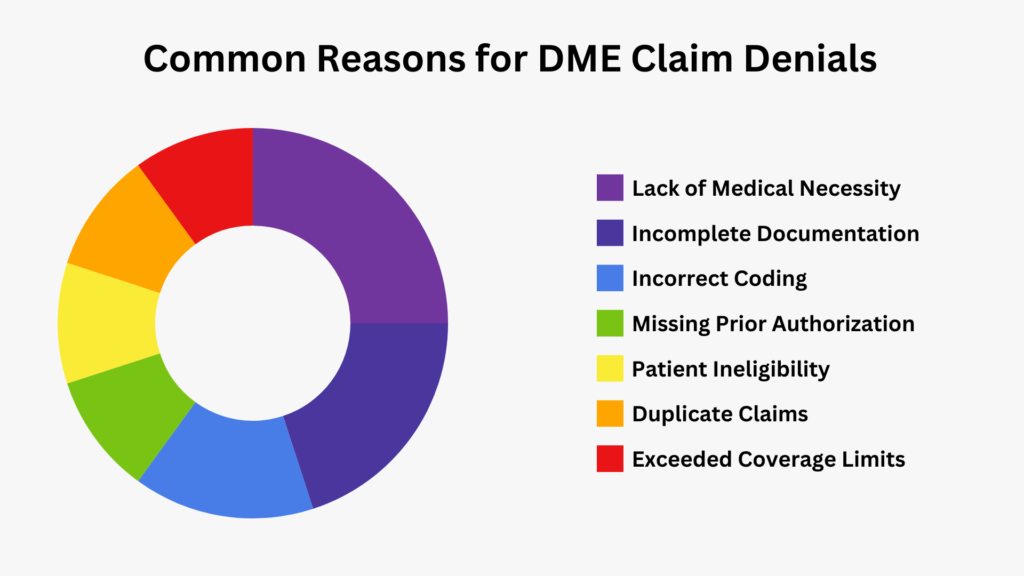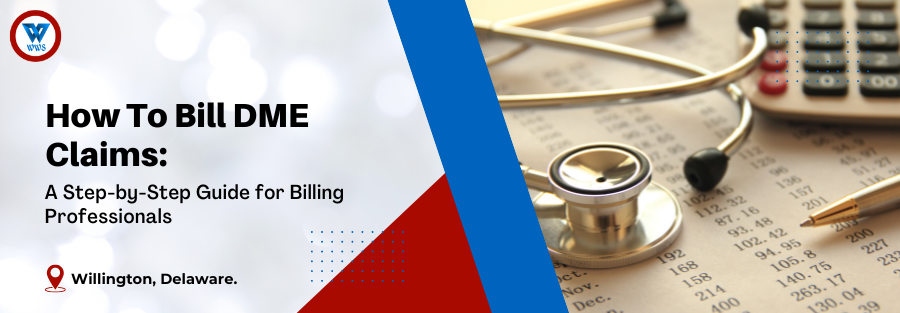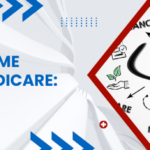Introduction
Billing Durable Medical Equipment (DME) claims accurately is crucial for ensuring timely reimbursement and maintaining compliance. This comprehensive guide will walk you through each step of the bill DME claim process, providing practical tips and best practices along the way.
Verify Patient and Insurance Information
Before you begin preparing a claim, it’s essential to verify all patient and insurance information.
Steps:
- Confirm patient’s personal details (name, DOB, address)
- Verify current insurance coverage and policy details
- Check for any secondary insurance
- Confirm the ordering physician’s information
Best Practices:
- Use automated eligibility verification tools when possible
- Document all verification attempts, including date and outcome
- Train staff on how to properly verify and record insurance information
Review and Confirm Medical Necessity
Ensuring medical necessity is documented is crucial for claim approval.
Key Components:
- Detailed Written Order (DWO) or prescription
- Relevant diagnostic codes (ICD-10)
- Documentation of face-to-face encounter (if required)
- Any required Certificates of Medical Necessity (CMN)
Best Practices:
- Develop a checklist for required documentation based on equipment type
- Implement a system for tracking and following up on missing documentation
- Regularly communicate with prescribing physicians about documentation requirements
[Insert image of a sample Detailed Written Order with key elements highlighted]
*Alt text: Sample Detailed Written Order for DME with crucial elements highlighted*
Select Appropriate HCPCS Codes and Modifiers
Accurate coding is essential for proper reimbursement and compliance.
Steps:
- Identify the correct HCPCS code for the equipment or supply
- Determine if any modifiers are necessary (e.g., NU for new equipment, RR for rental)
- Verify that the chosen codes align with the documented medical necessity
Best Practices:
- Use current coding resources and guidelines
- Implement a peer review process for complex coding situations
- Provide regular training and updates to billing staff on coding changes
Determine Proper Billing Units
Ensure you’re billing the correct number of units for the equipment or supplies.
Considerations:
- Is the item billed as a rental or purchase?
- For supplies, what is the appropriate quantity for the billing period?
- Are there any frequency limitations imposed by the payer?
Best Practices:
- Develop a quick reference guide for common DME items and their typical billing units
- Use billing software that can flag unusual quantities for review
- Regularly audit claims to ensure proper unit billing
Calculate and Verify Charges
Accurate charge calculation is crucial for proper reimbursement.
Steps:
- Determine the appropriate fee schedule (Medicare, Medicaid, or private payer)
- Apply any applicable discounts or contracted rates
- Verify that the calculated charge aligns with your cost and expected reimbursement
Best Practices:
- Regularly update your charge master with current fee schedules
- Implement automated charge calculation tools to reduce errors
- Conduct periodic audits to ensure charges are being calculated correctly
Prepare the Claim Form
Most DME claims are submitted on the CMS-1500 form or its electronic equivalent.
Key Information to Include:
- Patient and insured’s information (Sections 1-13)
- Date(s) of service (Section 24A)
- Place of service code (Section 24B)
- HCPCS code and modifiers (Section 24D)
- Diagnosis pointer (Section 24E)
- Charges (Section 24F)
- Days or units (Section 24G)
- NPI numbers (Sections 24J, 32A, 33A)
[Insert image of a sample completed CMS-1500 form for DME billing]
*Alt text: Sample completed CMS-1500 form for DME billing with key sections highlighted*
Best Practices:
- Use electronic claim preparation software to reduce errors
- Implement a quality check process before claim submission
- Keep a file of common claim scenarios for reference
Attach Required Documentation
Ensure all necessary documentation is included with the claim.
Common Attachments:
- Detailed Written Order (DWO)
- Certificate of Medical Necessity (CMN), if required
- Proof of Delivery (POD)
- Any additional medical records supporting necessity
Best Practices:
- Develop a checklist of required attachments based on equipment type and payer
- Use electronic documentation systems when possible for easier retrieval and attachment
- Implement a process for following up on any missing documentation
Submit the Claim
Once the claim is prepared and documentation is attached, it’s time to submit.
Submission Methods:
- Electronic submission (preferred for most payers)
- Paper submission (may be necessary for some payers or in specific circumstances)
Best Practices:
- Use electronic submission whenever possible for faster processing
- Implement claim scrubbing software to catch errors before submission
- Keep track of timely filing deadlines for each payer
Track and Follow Up on Submitted Claims
The billing process doesn’t end with claim submission. Tracking and follow-up are crucial.
Steps:
- Record the date of submission for each claim
- Monitor for acknowledgment of receipt from the payer
- Track expected payment dates
- Follow up on any claims not paid within the expected timeframe
Best Practices:
- Use a claim tracking system or software
- Establish a regular schedule for claim status checks
- Develop a process for addressing and appealing denied claims promptly
Handle Claim Denials and Rejections
Despite best efforts, some claims may be denied or rejected. Having a process to handle these situations is important.
Steps for Handling Denials:
- Review the reason for denial
- Determine if additional information or correction is needed
- Submit a corrected claim or appeal as appropriate
- Track the status of corrected claims and appeals
Best Practices:
- Analyze denial patterns to identify and address recurring issues
- Provide staff training on common denial reasons and how to prevent them
- Develop template appeal letters for common denial scenarios

Conclusion
Billing DME claims accurately requires attention to detail, thorough documentation, and a good understanding of payer requirements. By following these steps and implementing best practices, you can improve your claim accuracy, reduce denials, and ensure timely reimbursement for your DME services.
How WWS Can Streamline Your DME Claim Billing Process
At Worldwide Solutions Health Care Services (WWS), we understand the complexities of DME claim billing. Our team of experts can help you optimize your billing process, reduce denials, and improve your reimbursement rates.
Our Services Include:
- Comprehensive DME billing process assessment
- Staff training on best practices for DME claim preparation and submission
- Implementation of efficient claim tracking and follow-up systems
- Denial management and appeals support
- Ongoing compliance monitoring and updates
Take the Next Step
Ready to optimize your DME claim billing process? Schedule a Collaborative Discovery Meeting with WWS today. We’ll discuss your specific challenges and how our expertise can benefit your organization.
Schedule Your WWS Collaborative Discovery Meeting: https://calendly.com/wwshcs/wws-collaborative-discovery-meeting
Don’t let complex DME billing processes hold your organization back. Let WWS help you master the art of DME claim billing.



